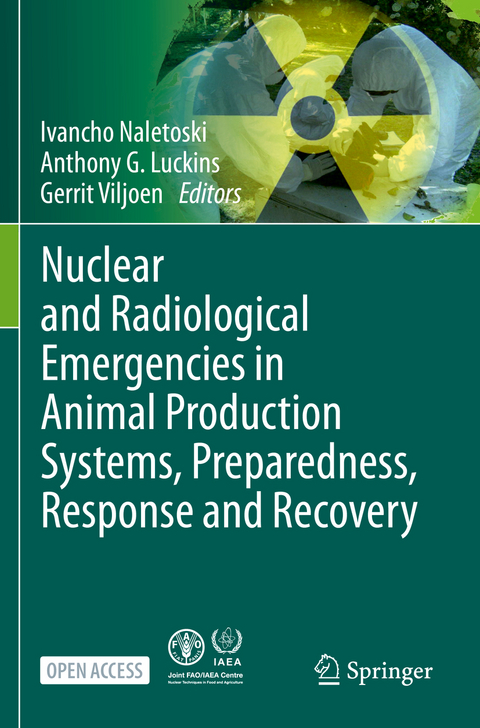
Nuclear and Radiological Emergencies in Animal Production Systems, Preparedness, Response and Recovery
Springer Berlin (Verlag)
978-3-662-63023-5 (ISBN)
This Open Access volume explains how major nuclear and radiological emergencies (NREs) can have implications at local, national and international level. The response to NREs requires a competent decision-making structure, clear communication and effective information exchange.
National veterinary services have the responsibility to plan, design and manage animal production system in their countries. These activities cover animal health, animal movement control, production control and improvement, and control of the products of animal origin before their placement on the market.
Release of radionuclides after NREs can cause substantial contamination in the animal production systems. Critical responsibility of veterinary authorities is therefore to prevent such contamination, establish early response mechanisms to mitigate the consequences and prevent placement of contaminated products of animal origin on the market for human consumption.
This work summarizes the critical technical points for effective management of NREs for national veterinary services.
Dr Ivancho NALETOSKI (PhD) is a staff member of the Animal Production and Health Section of the Joint FAO/IAEA Centre at the Headquarters of the International Atomic Energy Agency in Vienna, Austria since 2010. He is part of the team focusing on the development, validation and dissemination of diagnostic techniques for detection and characterization of transboundary animal and zoonotic diseases, application of stable isotope techniques for tracing long range migrations of migratory waterfowl and preparedness and response to nuclear and radiological emergencies in animal production systems. An important component of these activities is support in the integration of diagnostic technologies under ISO17025 standards in Member State veterinary laboratories and the dissemination of advanced molecular and immunological technologies to the veterinary laboratories of Member States. In addition, he is driving the application of real time geo-visualization tools and satellite remote sensing platforms for visualization of laboratory results, and integrating them, into the epidemiological strategies of the veterinary authorities in Member States.
Dr Gerrit Viljoen (DSc) is head of the Animal Production and Health Subprogramme of the Joint FAO/IAEA Centre situated in Vienna, Austria since 2003. The Joint FAO/IAEA Centre is unique in that it is the only International Organization that has its own R&D Laboratories. At any given time the Subprogramme is responsible for about 60 national country projects (on a two year cycle) and 8 Co-ordinated Research projects (on a five year cycle) mostly in developing IAEA and FAO Member States. The main aims of the programmatic activities are in the development and transfer of appropriate technologies, training of targeted Member State animal production and health counterparts, the development/establishment of research capabilities and in the evaluation, validation and harmonization of procedures to improve animal production systems.
Dr LUCKINS Antony (PhD) worked for over 30 years at the Centre for Tropical Veterinarary Medicine, Edinburgh, dealing primarily with the pathogenic animal trypanosomiases that cause major livestock and zoonotic diseases in countries in Africa, Asia and South America. He was responsible for development, evaluation and or validation of nuclear and nuclear-related methods for improved diagnosis and surveillance together with studies on the pathology and pathogenesis of disease and its effects on reproductive functions. His work involved teaching students to higher degree level, training of scientists and development and management of research projects in institutes in developing countries. He has contributed to a number of Joint FAO/IAEA Centre co-ordinated research programmes on immunoassay technologies and worked with the Janimal Production and Health Section in the creation of projects designed to determine the potential of gamma irradiation of transboundary animal disease pathogens to develop attenuated vaccines and the use of stable isotopes in understanding the the epidemiology and ecology of highly pathogenic avian influenza.
Foreword.- Preface.- About the Authors.- List of Abbreviations.- Chapter 1: National Veterinary Services Roles and Responsivities in Preparing for and Responding to Radiologic and Nuclear Emergencies.- Chapter 2: Basics of Radiobiology.- Chapter 3: Measurement of Radioactivity.- Chapter 4: Preparedness and Response to Nuclear and Radiological Emergencies in Animal Production Systems in the Context of IAEA Safety Standards.- Chapter 5: General Patterns of Contamination of Animals and Animal Products after Nuclear and Radiological Emergencies.- Chapter 6: Environmental Pathways of Radionuclides to Animal Products in Different Farming and Harvesting Systems.- Chapter 7: Management Options for Animal Production Systems- Which Ones to Choose in the Event of a Nuclear or Radiological Emergency?.- Chapter 8: Information Systems in Support of the Decision-Making Tools.- Annex A: Worked examples to illustrate decision aiding framework.- Annex B: Datasheets on the Management Options.
| Erscheinungsdatum | 23.09.2022 |
|---|---|
| Zusatzinfo | XX, 195 p. 38 illus., 31 illus. in color. |
| Verlagsort | Berlin |
| Sprache | englisch |
| Maße | 155 x 235 mm |
| Gewicht | 454 g |
| Themenwelt | Veterinärmedizin |
| Schlagworte | Animal Production Systems • disaster management • Nuclear and Radiological Emergencies • open access • Public Health • Radiological Contamination |
| ISBN-10 | 3-662-63023-0 / 3662630230 |
| ISBN-13 | 978-3-662-63023-5 / 9783662630235 |
| Zustand | Neuware |
| Informationen gemäß Produktsicherheitsverordnung (GPSR) | |
| Haben Sie eine Frage zum Produkt? |
aus dem Bereich


